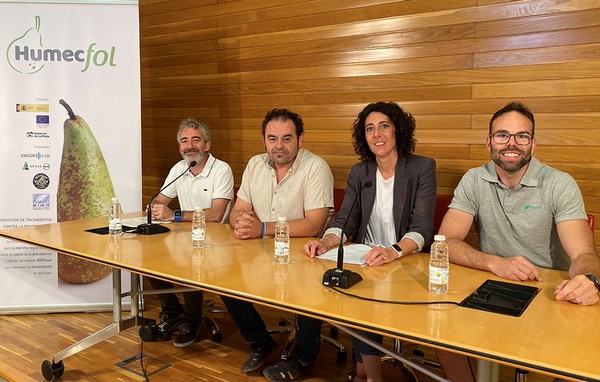The Humecfol innovation project has managed to develop a valid and economical leaf moisture sensor that will provide farmers with better phytosanitary control of the black spot affecting pear crops by improving the calculation accuracy of the BSPCast model.
This was explained on Tuesday by Sixto Cabezon, the general director of the Protected Designation of Origin (PDO) Pera de Rincon de Soto, in a conference with the members of the Humecfol Group, who developed the project and which is formed by the consultancy Econre Lab & Cesens, La Rioja's Agroclimatic Information Service, and ARAG-ASAJA.

According to Cabezon, one of the project's general goals was to better understand the risks of fungi in each of the PDO's plots through the development of a system that basically allowed two objectives. First, customizing the bioclimatic model calculations to each plot's particular moisture conditions by using Humecfol devices to measure said conditions. And secondly, increase the accuracy of the general information offered by La Rioja's Agroclimatic Information Service (SIAR), as it can now generate geographical information with risk information.
“We also had other objectives, such as improving phytosanitary control, having more accurate data to lower the consumption of phytosanitary products and avoiding carrying out unnecessary treatments, improving the competitiveness of our agriculture, and being more respectful with the environment.”
Based on these objectives, the project, which began in 2019, has also made it possible to “increase the profitability of the pear hectare by 5%-15%” by improving the organoleptic quality of the fruit and reducing the loss of production due to necrosis.
In addition, its promoters are considering extrapolating this technology to other crops in the region for the prediction of other diseases.
"We've verified that, in addition to the BSPCast model for the black spot on pear trees, several models work well for other diseases, such as mottling in apple trees, mildew in potatoes, yellow rust in wheat, Cercospora in beets, powdery mildew in vines, and there are indications that the Goidanich model works well for mildew in vines," stated Joaquin Huete, agricultural engineer of the SIAR.
Source: aragasaja.com
